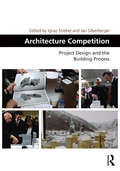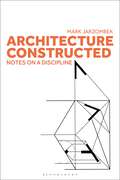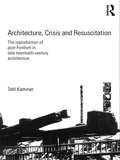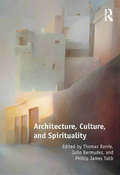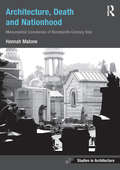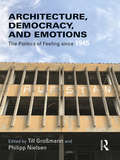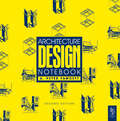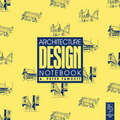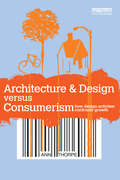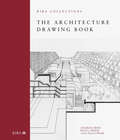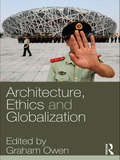- Table View
- List View
Architecture Competition: Project Design and the Building Process (Design and the Built Environment)
by Ignaz Strebel Jan SilberbergerMuch valued by design professionals, controversially discussed in the media, regularly misunderstood by the public and systematically regulated by public procurement; in recent years, architecture competitions have become projection screens for various and often incommensurable desires and hopes. Almost all texts on architectural competition engage it for particular reasons, whether these be for celebration of the procedure, or dismissal. Moving on from such polarised views, Architecture Competition is a revelatory study on what really happens when competitions take place. But the story is not just about architecture and design; it is about the whole construction process, from the definition of the spatial programme, to judgement and selection of projects and the realization of the building. This book explores the competition in the building process as it takes place, but also before and after its execution. It demonstrates that competitions are not just one step of many to be taken, but that competitive design procedures shape the entire process. Along the way the book exposes, among others, one of the key evolutions of design competitions – that competition procedures need to be regulated in order to respond to public awarding rules and need to integrate an increasing amount of given standards regarding, for example, efficiency, fire safety and thermal comfort. These notions force competing architects to respond to inflexible and overloaded competition programmes instead of focusing on genuinely crafting an architectural project. If the architecture competition wants to be more highly valued as a design tool, it should pay attention to the iterative nature of design and to the fact that perspectives on the problem often change in process.
Architecture Competition: Project Design and the Building Process (Design and the Built Environment)
by Ignaz Strebel Jan SilberbergerMuch valued by design professionals, controversially discussed in the media, regularly misunderstood by the public and systematically regulated by public procurement; in recent years, architecture competitions have become projection screens for various and often incommensurable desires and hopes. Almost all texts on architectural competition engage it for particular reasons, whether these be for celebration of the procedure, or dismissal. Moving on from such polarised views, Architecture Competition is a revelatory study on what really happens when competitions take place. But the story is not just about architecture and design; it is about the whole construction process, from the definition of the spatial programme, to judgement and selection of projects and the realization of the building. This book explores the competition in the building process as it takes place, but also before and after its execution. It demonstrates that competitions are not just one step of many to be taken, but that competitive design procedures shape the entire process. Along the way the book exposes, among others, one of the key evolutions of design competitions – that competition procedures need to be regulated in order to respond to public awarding rules and need to integrate an increasing amount of given standards regarding, for example, efficiency, fire safety and thermal comfort. These notions force competing architects to respond to inflexible and overloaded competition programmes instead of focusing on genuinely crafting an architectural project. If the architecture competition wants to be more highly valued as a design tool, it should pay attention to the iterative nature of design and to the fact that perspectives on the problem often change in process.
Architecture Constructed: Notes on a Discipline
by Mark JarzombekArchitecture Constructed explores the central, open secret of architecture: the long-suppressed conflict between arche and teckton-between those who design, and those who build. This unresolved tension has a centuries-old history in the discipline, persisting through Classical and Renaissance times to the present day, and yet it has rarely been addressed through a historical and theoretical lens.In this book, acclaimed architectural theorist Mark Jarzombek examines this tension head-on, and uses it to rethink the nature of the history of architecture. He reveals architecture to be a troubled, interconnected realm, incomplete and unstable, where labor, craft, and occupation are the 'invisible' complements to the work of the architect. Erudite, entertaining, and full of surprising and thought-provoking juxtapositions and challenges, Architecture Constructed is packed with novel insights into the internal conflicts and paradoxes of architecture, and is rich with examples from modern and contemporary practice-including Mies, Koolhaas, Potrc, Hadid, Bawa, Diller + Scofidio-which demonstrate how contemporary architecture inhabits the very same tensions that have riven the discipline since the days of Alberti.This provocative book will stimulate conversations among students, researchers, and designers, as it pushes the boundaries on how we define the professional discipline of architecture and overturns entrenched assumptions about the nature of architectural history and theory.
Architecture Constructed: Notes on a Discipline
by Mark JarzombekArchitecture Constructed explores the central, open secret of architecture: the long-suppressed conflict between arche and teckton-between those who design, and those who build. This unresolved tension has a centuries-old history in the discipline, persisting through Classical and Renaissance times to the present day, and yet it has rarely been addressed through a historical and theoretical lens.In this book, acclaimed architectural theorist Mark Jarzombek examines this tension head-on, and uses it to rethink the nature of the history of architecture. He reveals architecture to be a troubled, interconnected realm, incomplete and unstable, where labor, craft, and occupation are the 'invisible' complements to the work of the architect. Erudite, entertaining, and full of surprising and thought-provoking juxtapositions and challenges, Architecture Constructed is packed with novel insights into the internal conflicts and paradoxes of architecture, and is rich with examples from modern and contemporary practice-including Mies, Koolhaas, Potrc, Hadid, Bawa, Diller + Scofidio-which demonstrate how contemporary architecture inhabits the very same tensions that have riven the discipline since the days of Alberti.This provocative book will stimulate conversations among students, researchers, and designers, as it pushes the boundaries on how we define the professional discipline of architecture and overturns entrenched assumptions about the nature of architectural history and theory.
Architecture, Crisis and Resuscitation: The Reproduction of Post-Fordism in Late-Twentieth-Century Architecture
by Tahl KaminerStudying the relation of architecture to society, this book explains the manner in which the discipline of architecture adjusted itself in order to satisfy new pressures by society. Consequently, it offers an understanding of contemporary conditions and phenomena, ranging from the ubiquity of landmark buildings to the celebrity status of architects. It concerns the period spanning from 1966 to the first years of the current century – a period which saw radical change in economy, politics, and culture and a period in which architecture radically transformed, substituting the alleged dreariness of modernism with spectacle.
Architecture, Crisis and Resuscitation: The Reproduction of Post-Fordism in Late-Twentieth-Century Architecture
by Tahl KaminerStudying the relation of architecture to society, this book explains the manner in which the discipline of architecture adjusted itself in order to satisfy new pressures by society. Consequently, it offers an understanding of contemporary conditions and phenomena, ranging from the ubiquity of landmark buildings to the celebrity status of architects. It concerns the period spanning from 1966 to the first years of the current century – a period which saw radical change in economy, politics, and culture and a period in which architecture radically transformed, substituting the alleged dreariness of modernism with spectacle.
Architecture, Culture, and Spirituality
by Thomas Barrie Julio BermudezArchitecture has long been understood as a cultural discipline able to articulate the human condition and lift the human spirit, yet the spirituality of architecture is rarely directly addressed in academic scholarship. The seventeen chapters provide a diverse range of perspectives, grouped according to topical themes: Being in the World; Sacred, Secular, and the Contemporary Condition; Symbolic Engagements; Sacred Landscapes; and Spirituality and the Designed Environment. Even though the authors’ approach the subject from a range of disciplines and theoretical positions, all share interests in the need to rediscover, redefine, or reclaim the sacred in everyday experience, scholarly analysis, and design.
Architecture, Culture, and Spirituality
by Thomas Barrie Julio BermudezArchitecture has long been understood as a cultural discipline able to articulate the human condition and lift the human spirit, yet the spirituality of architecture is rarely directly addressed in academic scholarship. The seventeen chapters provide a diverse range of perspectives, grouped according to topical themes: Being in the World; Sacred, Secular, and the Contemporary Condition; Symbolic Engagements; Sacred Landscapes; and Spirituality and the Designed Environment. Even though the authors’ approach the subject from a range of disciplines and theoretical positions, all share interests in the need to rediscover, redefine, or reclaim the sacred in everyday experience, scholarly analysis, and design.
Architecture, Death and Nationhood: Monumental Cemeteries of Nineteenth-Century Italy (Ashgate Studies in Architecture)
by Hannah MaloneIn the nineteenth century, new cemeteries were built in many Italian cities that were unique in scale and grandeur, and which became destinations on the Grand Tour. From the Middle Ages, the dead had been buried in churches and urban graveyards but, in the 1740s, a radical reform across Europe prohibited burial inside cities and led to the creation of suburban burial grounds. Italy’s nineteenth-century cemeteries were distinctive as monumental or architectural structures, rather than landscaped gardens. They represented a new building type that emerged in response to momentous changes in Italian politics, tied to the fight for independence and the creation of the nation-state. As the first survey of Italy’s monumental cemeteries, the book explores the relationship between architecture and politics, or how architecture is formed by political forces. As cities of the dead, cemeteries mirrored the spaces of the living. Against the backdrop of Italy’s unification, they conveyed the power of the new nation, efforts to construct an Italian identity, and conflicts between Church and state. Monumental cemeteries helped to foster the narratives and mentalities that shaped Italy as a new nation.
Architecture, Death and Nationhood: Monumental Cemeteries of Nineteenth-Century Italy (Ashgate Studies in Architecture)
by Hannah MaloneIn the nineteenth century, new cemeteries were built in many Italian cities that were unique in scale and grandeur, and which became destinations on the Grand Tour. From the Middle Ages, the dead had been buried in churches and urban graveyards but, in the 1740s, a radical reform across Europe prohibited burial inside cities and led to the creation of suburban burial grounds. Italy’s nineteenth-century cemeteries were distinctive as monumental or architectural structures, rather than landscaped gardens. They represented a new building type that emerged in response to momentous changes in Italian politics, tied to the fight for independence and the creation of the nation-state. As the first survey of Italy’s monumental cemeteries, the book explores the relationship between architecture and politics, or how architecture is formed by political forces. As cities of the dead, cemeteries mirrored the spaces of the living. Against the backdrop of Italy’s unification, they conveyed the power of the new nation, efforts to construct an Italian identity, and conflicts between Church and state. Monumental cemeteries helped to foster the narratives and mentalities that shaped Italy as a new nation.
Architecture, Democracy and Emotions: The Politics of Feeling since 1945
by Till Großmann Philipp NielsenAfter 1945 it was not just Europe’s parliamentary buildings that promised to house democracy: hotels in Turkey and Dutch shopping malls proposed new democratic attitudes and feelings. Housing programs in the United Kingdom, the United States, and the Soviet Union were designed with the aim of creating new social relations among citizens and thus better, more equal societies. Architecture, Democracy, and Emotions focuses on these competing promises of consumer democracy, welfare democracy, and socialist democracy. Spanning from Turkey across Eastern and Western Europe to the United States, the chapters investigate the emotional politics of housing and representation during the height of the Cold War, as well as its aftermath post-1989. The book assembles detailed research on how the claims and aspirations of being "democratic" influenced the affects of architecture, and how these claims politicized space. Architecture, Democracy, and Emotions contributes to the study of Europe’s "democratic age" beyond Cold War divisions without diminishing political differences. The combination of an emotional history of democracy with an architectural history of emotions distinguishes the book’s approach from other recent investigations into the interconnection of mind, body, and space.
Architecture, Democracy and Emotions: The Politics of Feeling since 1945
by Till Großmann Philipp NielsenAfter 1945 it was not just Europe’s parliamentary buildings that promised to house democracy: hotels in Turkey and Dutch shopping malls proposed new democratic attitudes and feelings. Housing programs in the United Kingdom, the United States, and the Soviet Union were designed with the aim of creating new social relations among citizens and thus better, more equal societies. Architecture, Democracy, and Emotions focuses on these competing promises of consumer democracy, welfare democracy, and socialist democracy. Spanning from Turkey across Eastern and Western Europe to the United States, the chapters investigate the emotional politics of housing and representation during the height of the Cold War, as well as its aftermath post-1989. The book assembles detailed research on how the claims and aspirations of being "democratic" influenced the affects of architecture, and how these claims politicized space. Architecture, Democracy, and Emotions contributes to the study of Europe’s "democratic age" beyond Cold War divisions without diminishing political differences. The combination of an emotional history of democracy with an architectural history of emotions distinguishes the book’s approach from other recent investigations into the interconnection of mind, body, and space.
Architecture Description Languages: IFIP TC-2 Workshop on Architecture Description Languages (WADL), World Computer Congress, Aug. 22-27, 2004, Toulouse, France (IFIP Advances in Information and Communication Technology #176)
by Pierre Dissaux Mamoun Filali Amine Pierre Michel Francois VernadatArchitecture Description Languages is an essential reference for both academic and professional researchers in the field of system engineering and design. The papers presented in this volume were selected from the workshop of the same name that was held as part of the World Computer Congress 2004 Conference, held in Toulouse, France in August 2004. This collection presents significant research and innovative developments and applications from both academic researchers and industry practitioners on topics ranging from Semantics to Tool and Development Environments. The aim of an ADL is to formally describe software and hardware architectures. Usually, an ADL describes components, their interfaces, their structures, their interactions (structure of data flow and control flow) and the mappings to hardware systems. A major goal of such description is to allow analysis with respect to several aspects like timing, safety, reliability. The papers in this state-of-the-art volume cover such topics of interest as components, connectors, composition; semantics and formalization; verification, simulation and test; tools and development environments; standardization; industrial projects. To encourage closer interaction between academic and industrial networking research communities, the workshop welcomed academic research papers as well as industrial contributions, and both are included here. Which makes this collection important not only for ADL experts and researchers, but also for all teachers and administrators interested in ADL.
Architecture Design and Validation Methods
by Egon BörgerThis state-of-the-art survey gives a systematic presentation of recent advances in the design and validation of computer architectures. The book covers a comprehensive range of architecture design and validation methods, from computer aided high-level design of VLSI circuits and systems to layout and testable design, including the modeling and synthesis of behavior and dataflow, cell-based logic optimization, machine assisted verification, and virtual machine design.
Architecture Design for Soft Errors
by Shubu MukherjeeArchitecture Design for Soft Errors provides a comprehensive description of the architectural techniques to tackle the soft error problem. It covers the new methodologies for quantitative analysis of soft errors as well as novel, cost-effective architectural techniques to mitigate them. To provide readers with a better grasp of the broader problem definition and solution space, this book also delves into the physics of soft errors and reviews current circuit and software mitigation techniques. There are a number of different ways this book can be read or used in a course: as a complete course on architecture design for soft errors covering the entire book; a short course on architecture design for soft errors; and as a reference book on classical fault-tolerant machines. This book is recommended for practitioners in semi-conductor industry, researchers and developers in computer architecture, advanced graduate seminar courses on soft errors, and (iv) as a reference book for undergraduate courses in computer architecture.Helps readers build-in fault tolerance to the billions of microchips produced each year, all of which are subject to soft errorsShows readers how to quantify their soft error reliabilityProvides state-of-the-art techniques to protect against soft errors
Architecture Design Notebook
by A Peter FawcettArchitecture Design Notebook focuses on the process of design as pragmatic and non-theoretical. Dealing systematically with the core design curriculum, it clearly demonstrates the skills required for designing at undergraduate level. Providing students with fundamental maxims of design, and a framework within which they can approach their work, this book supports undergraduates as they learn to produce solutions to design challenges. This vital design companion underpins the cornerstone of an architectural undergraduates' studies - studio design projects. With over 100 sketches included, the book inspires student's design ideas. This updated edition includes new sections on green architecture, urban space typology, and the virtual building. A. Peter Fawcett is an architect and critic who combines teaching with sporadic practice; he is currently Professor Emeritus of Architecture at the University of Nottingham and visiting Professor at the University of Lincoln. In recent years his work has been placed in architectural competitions and has been hung at the Royal Academy and Royal Ulster Academy.
Architecture Design Notebook
by A Peter FawcettArchitecture Design Notebook focuses on the process of design as pragmatic and non-theoretical. Dealing systematically with the core design curriculum, it clearly demonstrates the skills required for designing at undergraduate level. Providing students with fundamental maxims of design, and a framework within which they can approach their work, this book supports undergraduates as they learn to produce solutions to design challenges. This vital design companion underpins the cornerstone of an architectural undergraduates' studies - studio design projects. With over 100 sketches included, the book inspires student's design ideas. This updated edition includes new sections on green architecture, urban space typology, and the virtual building. A. Peter Fawcett is an architect and critic who combines teaching with sporadic practice; he is currently Professor Emeritus of Architecture at the University of Nottingham and visiting Professor at the University of Lincoln. In recent years his work has been placed in architectural competitions and has been hung at the Royal Academy and Royal Ulster Academy.
Architecture & Design versus Consumerism: How Design Activism Confronts Growth
by Ann ThorpeThe mentality that consumerism and economic growth are cure-alls is one of the biggest obstacles to real sustainability, but any change seems impossible, unthinkable. Our contemporary paradox finds us relying for our well being on consumer-driven economic growth that we actually can’t afford — not in environmental, economic or social terms. Although architecture and design have long been seen as engines for consumerism and growth, increasing numbers of designers are concerned about the problems resulting from growth. But designers face a paradox of their own; in scenarios of sustainable consumption, where people consume or build significantly less, what will be left for designers to do? This book, informed by recent research into the viability of a "steady state" economy, sets an agenda for addressing the designer’s paradox of sustainable consumption. The agenda includes ways that architecture and design can help transition us towards a new kind of economy that prioritizes real wellbeing rather than economic growth. Packed with examples and illustrations, the book argues that taking action, or activism, is an important but so far underexplored way for architects and designers to confront consumerism. The first chapters explore how economic growth and consumerism shape and are shaped by the professions of architecture, product, and landscape design and how we can understand the problem of consumerism as four main challenges that designers are already addressing. The book maps out the main issues surrounding the development of metrics that designers and others can use to measure wellbeing, instead of simply measuring economic growth. The second half of the book looks at how design activism works and its connection to growth and consumerist issues. These chapters examine how activist practices are financed, highlight five specific methods that designers use in working for social change, and investigate the power of these methods. The book concludes with a consideration of what design’s role might be in a "post-growth" society.
Architecture & Design versus Consumerism: How Design Activism Confronts Growth
by Ann ThorpeThe mentality that consumerism and economic growth are cure-alls is one of the biggest obstacles to real sustainability, but any change seems impossible, unthinkable. Our contemporary paradox finds us relying for our well being on consumer-driven economic growth that we actually can’t afford — not in environmental, economic or social terms. Although architecture and design have long been seen as engines for consumerism and growth, increasing numbers of designers are concerned about the problems resulting from growth. But designers face a paradox of their own; in scenarios of sustainable consumption, where people consume or build significantly less, what will be left for designers to do? This book, informed by recent research into the viability of a "steady state" economy, sets an agenda for addressing the designer’s paradox of sustainable consumption. The agenda includes ways that architecture and design can help transition us towards a new kind of economy that prioritizes real wellbeing rather than economic growth. Packed with examples and illustrations, the book argues that taking action, or activism, is an important but so far underexplored way for architects and designers to confront consumerism. The first chapters explore how economic growth and consumerism shape and are shaped by the professions of architecture, product, and landscape design and how we can understand the problem of consumerism as four main challenges that designers are already addressing. The book maps out the main issues surrounding the development of metrics that designers and others can use to measure wellbeing, instead of simply measuring economic growth. The second half of the book looks at how design activism works and its connection to growth and consumerist issues. These chapters examine how activist practices are financed, highlight five specific methods that designers use in working for social change, and investigate the power of these methods. The book concludes with a consideration of what design’s role might be in a "post-growth" society.
The Architecture Drawing Book: RIBA Collections
by Charles Hind Fiona Orsini Susan PughA club house in a castle in the West End of London, complete with battlements and turrets, from 1882. A design for the post-war reconstruction of the City of London in 1945. A fantasy landscape featuring Le Corbusier’s Capriccio of Notre-Dame du Haut in ruins. A section of a 19th-century townhouse, showing a slice of the staircase wallpaper winding from deep navy on the ground floor to pale sky blue at the top. This is a treasury of architectural drawing from the 16th century to the present day. Exploring both how and why architects draw, it offers a rich visual history from Palladio, Inigo Jones and Augustus Pugin to contemporaries such as Richard Rogers, Foster Associates and Zaha Hadid, via Sir Christopher Wren, George Gilbert Scott and Erno Goldfinger, and everything else in between. From back-of-envelope concept sketches to painstaking pen and ink perspectives, exploded axonometrics and born-digital drawings, this book celebrates the full gamut of architectural representation. With over 200 lush, full-colour reproductions, this is a window into soul of architectural drawing over the past five hundred years. Includes newly digitised, never-seen-before material from the RIBA Collections, one of the largest architectural archives in the world. Explores rare drawings and designs from John Nash, Sir Edwin Lutyens, Frank Lloyd Wright and many more. Insightful commentary alongside each drawing ensures that they are as accessible and engaging as possible. Wide-ranging in scope, this book will both inspire and inform.
The Architecture Drawing Book: RIBA Collections
by Charles Hind Fiona Orsini Susan PughA club house in a castle in the West End of London, complete with battlements and turrets, from 1882. A design for the post-war reconstruction of the City of London in 1945. A fantasy landscape featuring Le Corbusier’s Capriccio of Notre-Dame du Haut in ruins. A section of a 19th-century townhouse, showing a slice of the staircase wallpaper winding from deep navy on the ground floor to pale sky blue at the top. This is a treasury of architectural drawing from the 16th century to the present day. Exploring both how and why architects draw, it offers a rich visual history from Palladio, Inigo Jones and Augustus Pugin to contemporaries such as Richard Rogers, Foster Associates and Zaha Hadid, via Sir Christopher Wren, George Gilbert Scott and Erno Goldfinger, and everything else in between. From back-of-envelope concept sketches to painstaking pen and ink perspectives, exploded axonometrics and born-digital drawings, this book celebrates the full gamut of architectural representation. With over 200 lush, full-colour reproductions, this is a window into soul of architectural drawing over the past five hundred years. Includes newly digitised, never-seen-before material from the RIBA Collections, one of the largest architectural archives in the world. Explores rare drawings and designs from John Nash, Sir Edwin Lutyens, Frank Lloyd Wright and many more. Insightful commentary alongside each drawing ensures that they are as accessible and engaging as possible. Wide-ranging in scope, this book will both inspire and inform.
Architecture, Ethics and Globalization
by Graham OwenBridging the gap between architectural theory and professional practice studies, this book offers critical inquiry into the shifting ground of ethical thought in the changing climate of the global economy. Looking at issues of contemporary significance to architectural critics, practitioners, educators, and students, the book also examines the role of the architectural academy in providing an education in ethical judgement. Including transcripts of responses and discussions among its contributors, a broad interdisciplinary set of perspectives are debated and often controversial points of view are put forward.
Architecture, Ethics and Globalization
by Graham OwenBridging the gap between architectural theory and professional practice studies, this book offers critical inquiry into the shifting ground of ethical thought in the changing climate of the global economy. Looking at issues of contemporary significance to architectural critics, practitioners, educators, and students, the book also examines the role of the architectural academy in providing an education in ethical judgement. Including transcripts of responses and discussions among its contributors, a broad interdisciplinary set of perspectives are debated and often controversial points of view are put forward.
Architecture Exploration for Embedded Processors with LISA
by Andreas Hoffmann Heinrich Meyr Rainer LeupersToday more than 90% of all programmable processors are employed in embedded systems. The LISA processor design platform presented in this book addresses recent design challenges and results in highly satisfactory solutions, covering all major high-level phases of embedded processor design.
Architecture Exploration of FPGA Based Accelerators for BioInformatics Applications (Springer Series in Advanced Microelectronics #55)
by B. Sharat Varma Kolin Paul M. BalakrishnanThis book presents an evaluation methodology to design future FPGA fabrics incorporating hard embedded blocks (HEBs) to accelerate applications. This methodology will be useful for selection of blocks to be embedded into the fabric and for evaluating the performance gain that can be achieved by such an embedding. The authors illustrate the use of their methodology by studying the impact of HEBs on two important bioinformatics applications: protein docking and genome assembly. The book also explains how the respective HEBs are designed and how hardware implementation of the application is done using these HEBs. It shows that significant speedups can be achieved over pure software implementations by using such FPGA-based accelerators. The methodology presented in this book may also be used for designing HEBs for accelerating software implementations in other domains besides bioinformatics. This book will prove useful to students, researchers, and practicing engineers alike.
